Research of Automatic Generation for Engineering Geological Survey Reports Based on a Four-Dimensional Dynamic Template
Abstract
1. Introduction
2. Related Work
3. Variable Features of Reports and the Four-Dimensional Dynamic Template
3.1. Types of Variable Features of Reports
3.2. Four-Dimensional Dynamic Template (FDDT)
3.3. Four-Dimensional Dynamic Model
4. Methods and Technology
4.1. Related Theory
4.1.1. Relational Database and Graph Database
4.1.2. Stored Procedure
4.1.3. LaTeX Coding
4.2. Technical Route
4.2.1. Template Definition
4.2.2. Template Editing
4.2.3. Template Storage
4.2.4. Report Generation
4.3. System Development
4.3.1. Development and Operating Environment
4.3.2. System Architecture
- Customization management: through the template definition interface (Figure 5), we convert the established Word report template into the document template tree in the system memory, give each node the properties of name, type and text, and establish the relationship between the dynamic part of the template tree and its data source.
- Interactive management: query, modify, and delete node information to meet template requirements.
- Retrieval management: a template consists of multiple outline trees and paragraph trees. The correspondence between the template number and the tree is stored in the relation table. We change the template by querying and modifying relation table.
- Storage management: the storage methods of different forms of templates are different. For example, document templates are saved as files, tree structure templates are saved in a graph database, and template relation records are in a relational database.
- Data management: the input data of the current system is the result of analysis of the mapping, exploration, and laboratory test data, which is stored in a relational database; the query result data by traversing the template tree of the graph database are stored into the relational database; The stored procedure retrieves template structure data, survey data, and format data based on incoming template information, and integrates them into a string for subsequent report generation.
- Format management: the report format information can be adjusted according to the report usage or purpose. A template not only contains a variety of format information, but also achieves dynamic text field formatting.
5. Experiment
5.1. Data Description
5.2. Experimental Results
5.3. Effect Analysis
- Outline structures: in the document generation method based on FDDT, the report outline structure can be adjusted with the presence or absence of dynamic data in the template, that is, the dynamic data greatly affects the outline structure of the final generated report. As shown in Figure 7a,b, the existence of special rock soil data determines whether Section 4.2 is further sub-sectioned. Once the outline structure of the template used by other document generation methods based on template is determined, it is difficult to modify, and the outline structure will not be adjusted according to the dynamic data, which have low flexibility.
- Paragraph content: when there is a multi-branch sentence in a text paragraph, the document generation method based on FDDT can choose different branches according to varied conditions in order to better adapt to the changing characteristics of that paragraph. As shown in Figure 8b, if the intersection of two faults and the route is different, the selected fault description sentence is also different. Other document generation methods based on template can only generate reports with fixed paragraph structures, and do not involve automatic selection of sentences within the paragraph. The document generation method based on FDDT can also generate tables with complex styles and flexible growth of rows and columns. By comparison, the structure and format of the table template used in other document generation methods based on template are simple and fixed. These are not suitable for generating complex dynamic tables.
- Format details: in the document generation method based on FDDT, the report format information can be adjusted in the light of the report usage or purpose. A template not only contains a variety of format information, but also achieves dynamic text field formatting. As shown in Figure 8a, the composition of the fracture zone is displayed in bold. While the template format used by other document generation methods based on template is fixed, this approach can achieve single fixed text formatting, but does not involve dynamic text field formatting. For example, paper [23] requires that the format of the table and the content of the header should be fixed according to the standard format of the report when creating a template.
- Dynamic data sources: In the document generation method based on FDDT, there are various methods for obtaining dynamic data, such as SQL Query, stored procedures, and functions. As shown in Figure 8a and Figure 9a, the composition of the fracture zone is obtained by SQL Query, and the table content is the return value of stored procedure. These methods are similar to some document generation methods based on templates, such as the data query method in paper [23] and the data processing method in paper [24]. The primary difference is that the data source methods of the document generation method based on FDDT can be dynamically adjusted, different source methods can be selected flexibly in the light of the needs when defining different templates, while the data source methods of other document generation methods based on template are fixed. For example, paper [23] and paper [24] use SQL statement to query data.
6. Conclusions
Author Contributions
Funding
Conflicts of Interest
References
- Liang, H.K. Discussion on the preparation of highway engineering geological survey report. Commun. Sci. Technol. Heilongjiang 2015, 38, 10. [Google Scholar] [CrossRef]
- Gao, X.Z. Analysis and summary of engineering examples of misuse of normative formulas in engineering geological survey reports. Sci. Technol. Inf. 2013, 25, 325–326. [Google Scholar]
- Ma, Y.Z.; Zhang, J.P.; Zheng, Y.H. Research on Automatic Generation of Documents for Automotive Radiator Design Calculation Platform. J. Qingdao Univ. Eng. Technol. 2013, 28, 71–75. [Google Scholar]
- Jiang, P.; Xu, F.; Qi, R.Z. Construction of a Flood Control Document Intelligent Generation Model Based on Cloud Platform. Water Resour. Informatiz. 2013, 25–32. [Google Scholar]
- Chen, Y.Y.; Xue, J.N.; Yu, H.H. Quick and automatic generation method for the evaluation report of the small hydropower substitute fuel project. In Proceedings of the 9th IFIP WG 5.14 International Conference on Computer and Computing Technologies in Agriculture, Beijing, China, 27–30 September 2015; pp. 64–71. [Google Scholar]
- Reiter, E.; Mellish, C.; Levine, J. Automatic generation of technical documentation. Appl. Artif. Intell. 1995, 9. [Google Scholar] [CrossRef]
- PadmaLahari, E.; Kumar, D.S.; Prasad, S. Automatic text summarization with statistical and linguistic features using successive thresholds. In Proceedings of the 2014 IEEE International Conference on Advanced Communications, Control and Computing Technologies, Syed Ammal Engineering College, Ramanathapuram, India, 8–10 May 2014; pp. 492–496. [Google Scholar]
- Khan, A.; Salim, N.; Farman, H. Abstractive text summarization based on improved semantic graph approac. Int. J. Parrallel Program. 2018, 46, 992–1016. [Google Scholar] [CrossRef]
- Kupiec, J.; Pedersen, J.; Chen, F. A trainable document summarizer. In Proceedings of the 18th Annual International ACM SIGIR Conference on Research and Development in Information Retrieval, Seattle, WA, USA, 9–13 July 1995. [Google Scholar]
- Serban, I.V.; Lowe, R.; Charlin, L. Generative deep neural networks for dialogue: A short review. arXiv 2016, arXiv:1611.06216. [Google Scholar]
- Clerwall, C. Enter the robot journalist: Users’ perceptions of automated content. Journal. Pract. 2014, 8, 519–531. [Google Scholar] [CrossRef]
- Abdul-Kader, S.A.; Woods, J.C. Survey on chatbot design techniques in speech conversation systems. Int. J. Adv. Comput. Sci. Appl. 2015, 6, 72–80. [Google Scholar]
- Klisarova-Belcheva, S.; Ilieva, G.; Yankova, T. Business intelligence and analytics–contemporary system model. Trakia J. Sci. 2017, 15. [Google Scholar] [CrossRef]
- Li, H.; Chiang, H.D.; Gale, W.G. A novel system for automatic generation of service reliability reports from automated mapping and facility management (AM/FM) systems. IEEE Trans. Power Syst. 2016, 17, 812–817. [Google Scholar] [CrossRef]
- Colineau, N.; Paris, C.; Linden, K.V. Automatically generating citizen-focused brochures for public administration. In Proceedings of the 12th Annual International Digital Government Research Conference: Digital Government Innovation in Challenging Times, College Park, MD, USA, 12–15 June 2011; pp. 10–19. [Google Scholar]
- Li, Q.; Liu, R.K.; Sun, Q.X. Research of automatic progress report generation for railway construction projects in China. Adv. Mech. Eng. 2015, 7. [Google Scholar] [CrossRef]
- Jia, Q.Z.; Xiao, B. The universalization of data interaction technology research between database and spreadsheet of WORD based on OLE. In Proceedings of the 2016 International Conference on Sustainable Energy, Environment and Information Engineering, Bangkok, Thailand, 20–21 March 2016; pp. 181–186. [Google Scholar]
- Yang, H.J.; Jia, Q.Z. Automatic synchronization technology of report data based on OLE. In Proceedings of the 2nd International Conference on Materials Science, Resource and Environmental Engineering (MSREE 2017), Wuhan, China, 27–29 October 2017. [Google Scholar]
- Huynh, E.; Roach, J.D.; McLaren, T. A computer-assisted method for pathogenicity assessment and genetic reporting of variants stored in the Australian Inherited Retinal Disease Register. Australas. Coll. Phys. Sci. Eng. Med. 2016, 39, 239–245. [Google Scholar] [CrossRef] [PubMed]
- Lu, B.Y.; Yang, X.F. Generating Word report and dynamic structure table with Delphi. Comput. Appl. Softw. 2007, 180–183. [Google Scholar] [CrossRef]
- Ge, F.; Wu, N. Platform for automatically producing word document based on multiple techniques. J. Univ. Electron. Sci. Technol. China 2007, 36, 263–266. [Google Scholar]
- Cai, X.; Shen, W.; Li, L.; Ge, Y.; Lu, L.; Zeng, L. Research and Implementation of Word Documents Generation Based on C#. In 2015 International Conference on Electronic Science and Automation Control; Atlantis Press: Amsterdam, The Netherlands, 2015. [Google Scholar] [CrossRef][Green Version]
- Dong, G.Z. Design and Implementation of Logging Report Generation System Based on .NET. Mud Logging Eng. 2014, 25, 70–72. [Google Scholar]
- Liu, P.; Qin, W.; Zhou, Y.H. Automatic generation method of word report based on dynamic web page. Comput. Eng. 2012, 38, 279–284. [Google Scholar] [CrossRef]
- Qu, M.C.; Liao, M.H.; Wu, X.H. Construction and application of an automatic document generation model. Comput. Integr. Manuf. Syst. 2008, 1297–1305. [Google Scholar]
- Jiang, C.M.; Wu, X.H.; Qu, M.C. Automatic document generation strategy for graphic-oriented modeling and automatic code generation platform. J. Theor. Appl. Inf. Technol. 2012, 45, 342–349. [Google Scholar]
- Robinson, I.; Webber, J.; Eifren, E. Options for storing connected data. In Graph Databases; O’Reilly Media, Inc.: Sebastopol, CA, USA, 2013; pp. 11–23. [Google Scholar]
- Miller, J.J. Graph database applications and concepts with Neo4j. In Proceedings of the Southern Association for Information Systems Conference, Atlanta, GA, USA, 23–24 March 2013; pp. 141–147. [Google Scholar]
- Van Bruggen, R. Graphs and graph theory-an introduction. In Learning Neo4j; Packt Publishing Ltd.: Birmingham, UK, 2014; pp. 7–20. [Google Scholar]
- Sunderic, D. Microsoft SQL Server 2005 Stored Procedure Programming in T-SQL &. NET; McGraw-Hill, Inc.: New York, NY, USA, 2006. [Google Scholar]
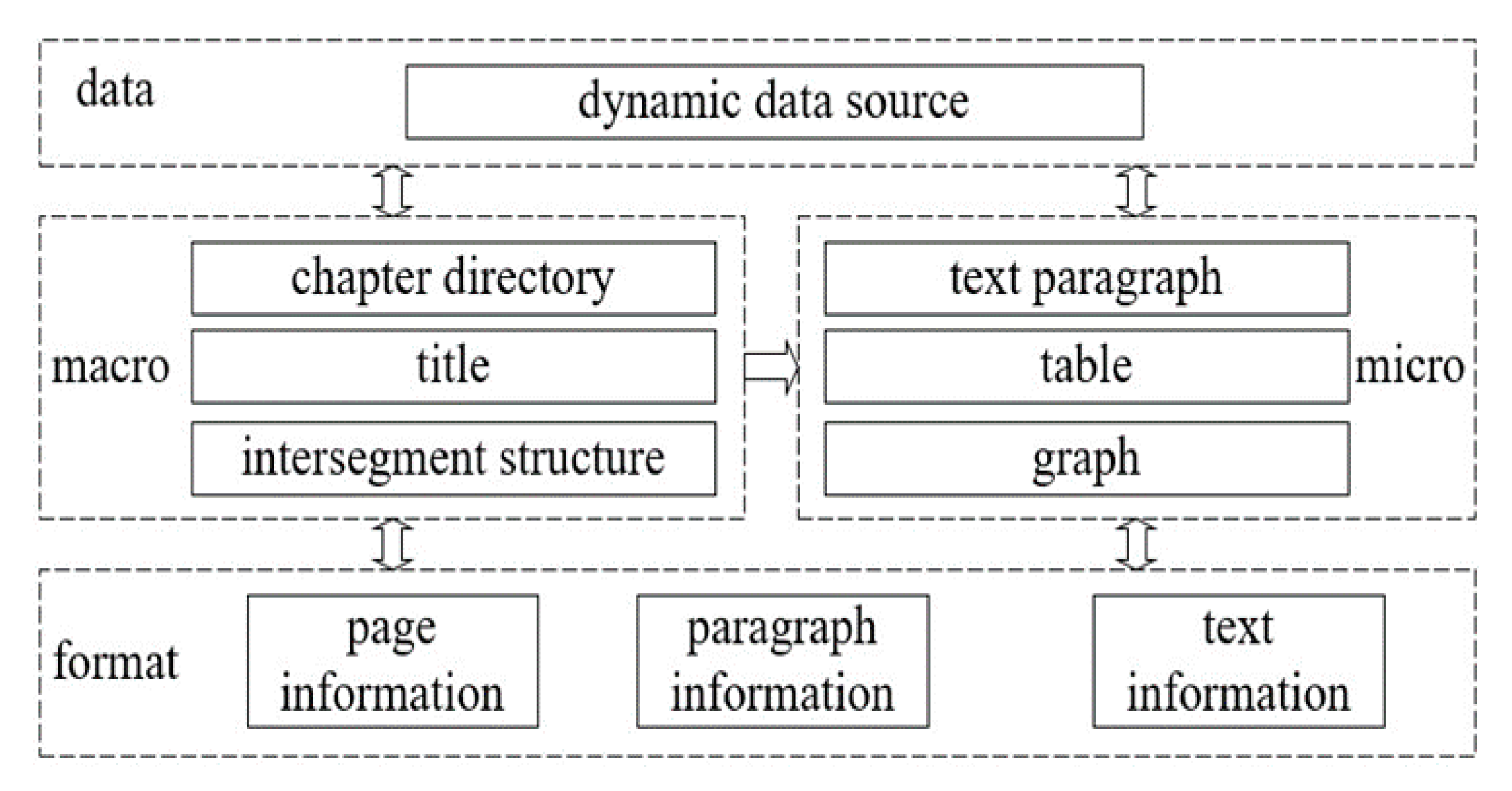


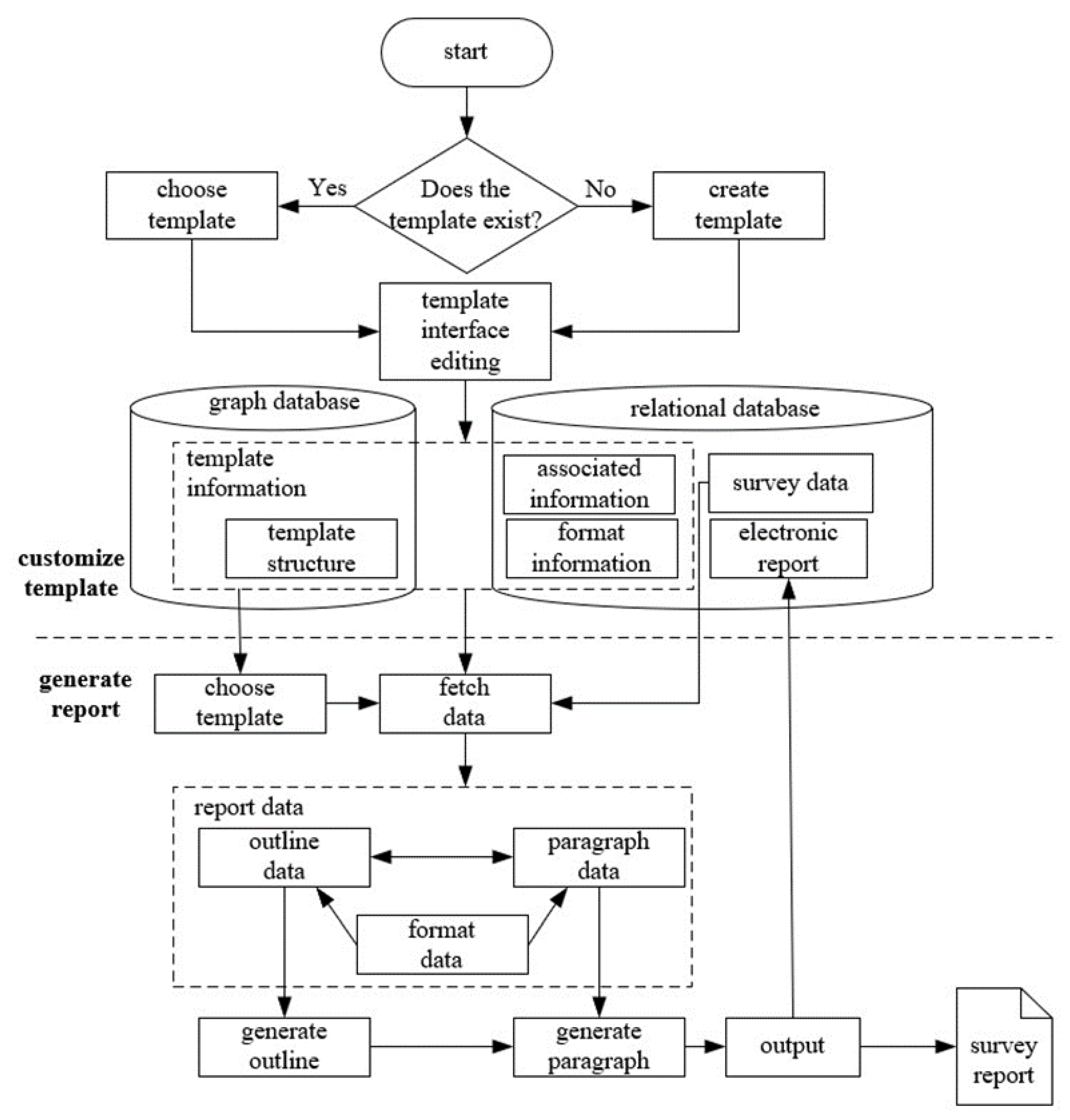
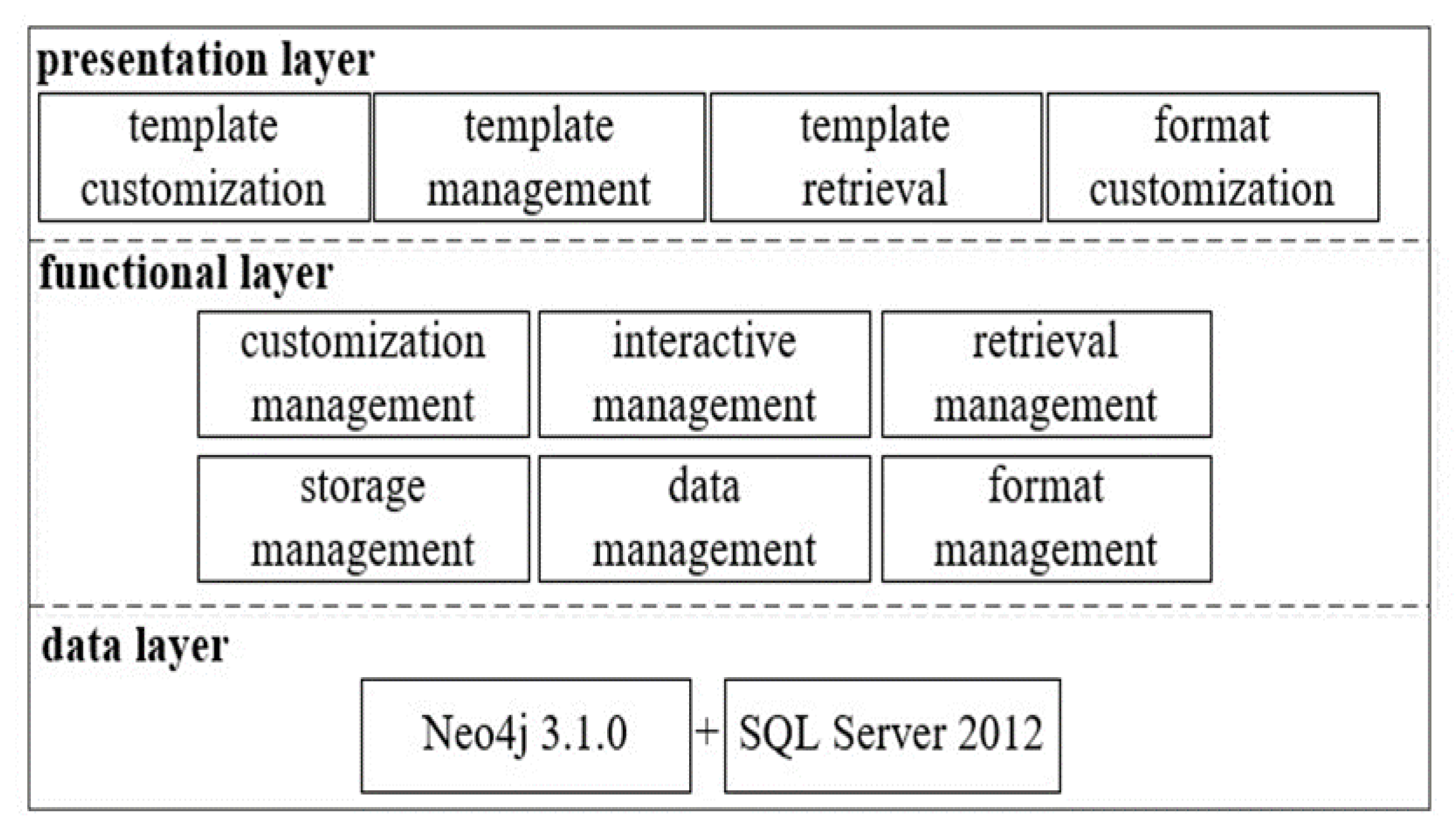


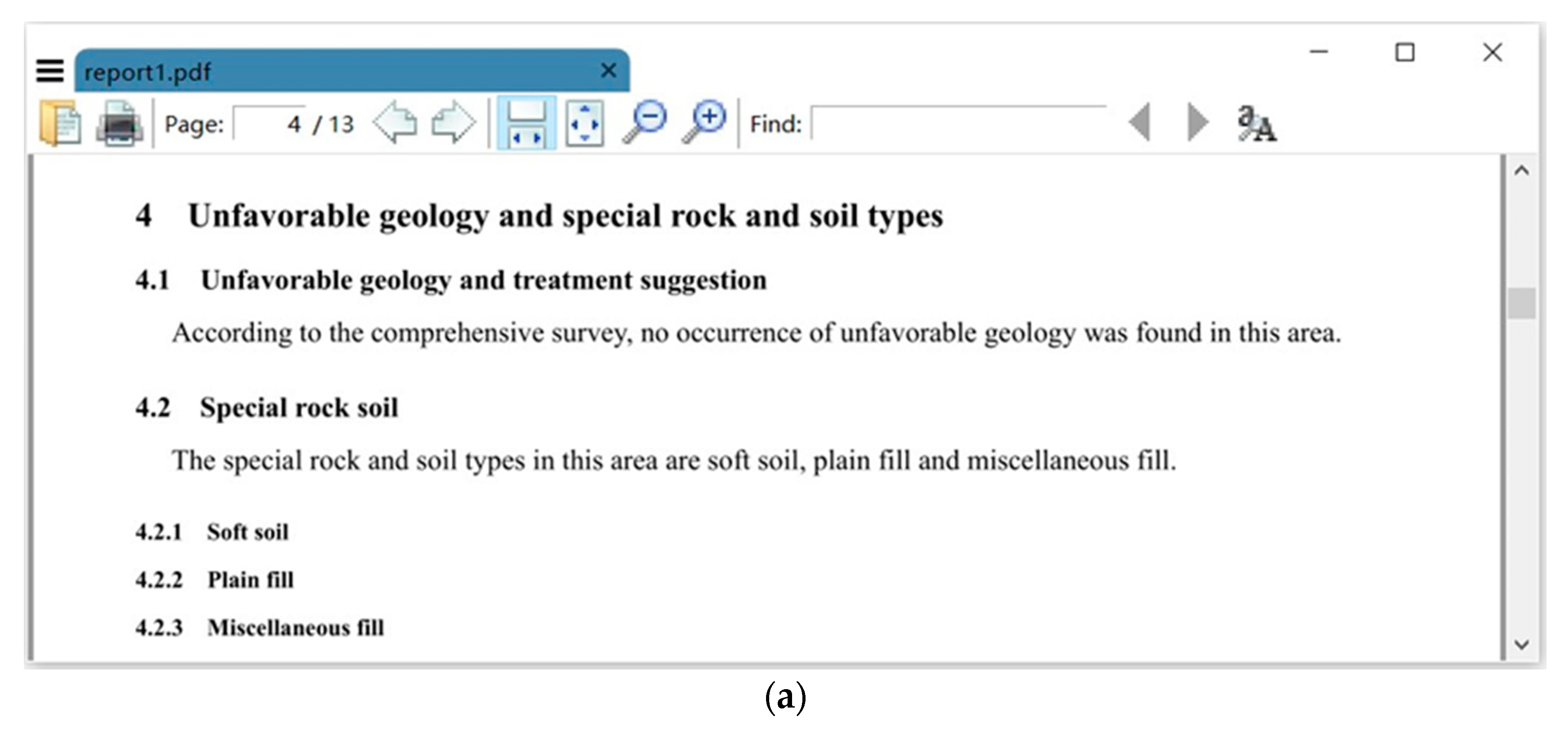
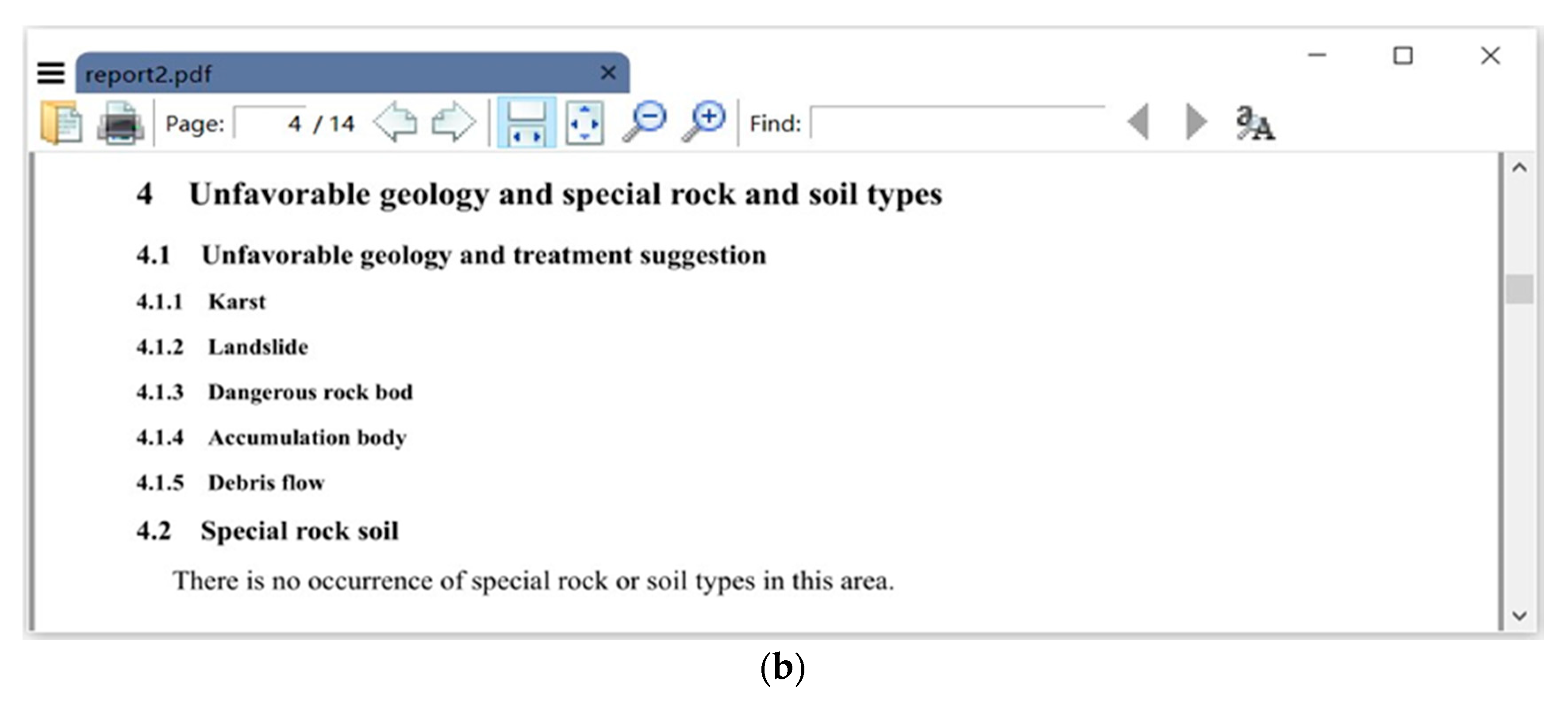
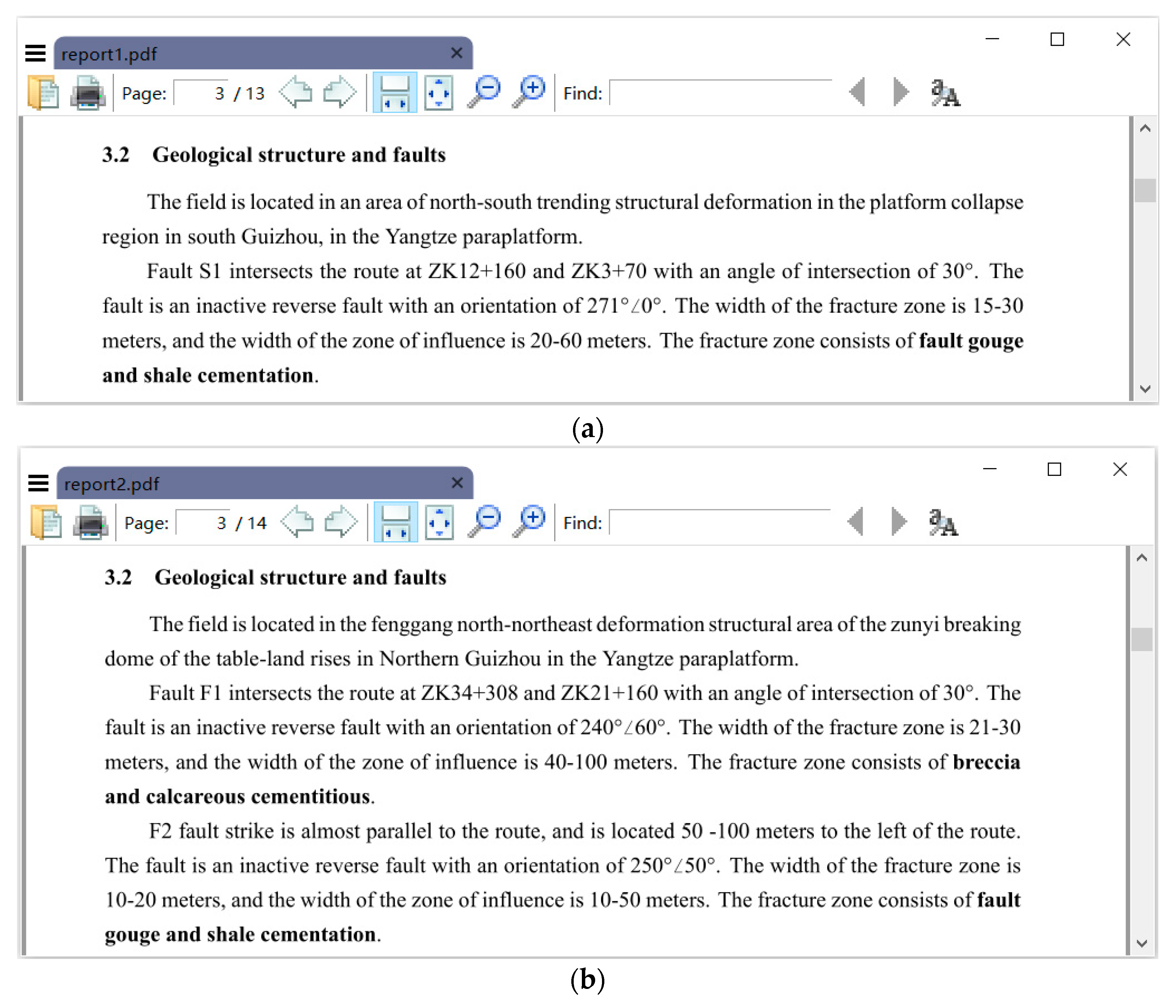

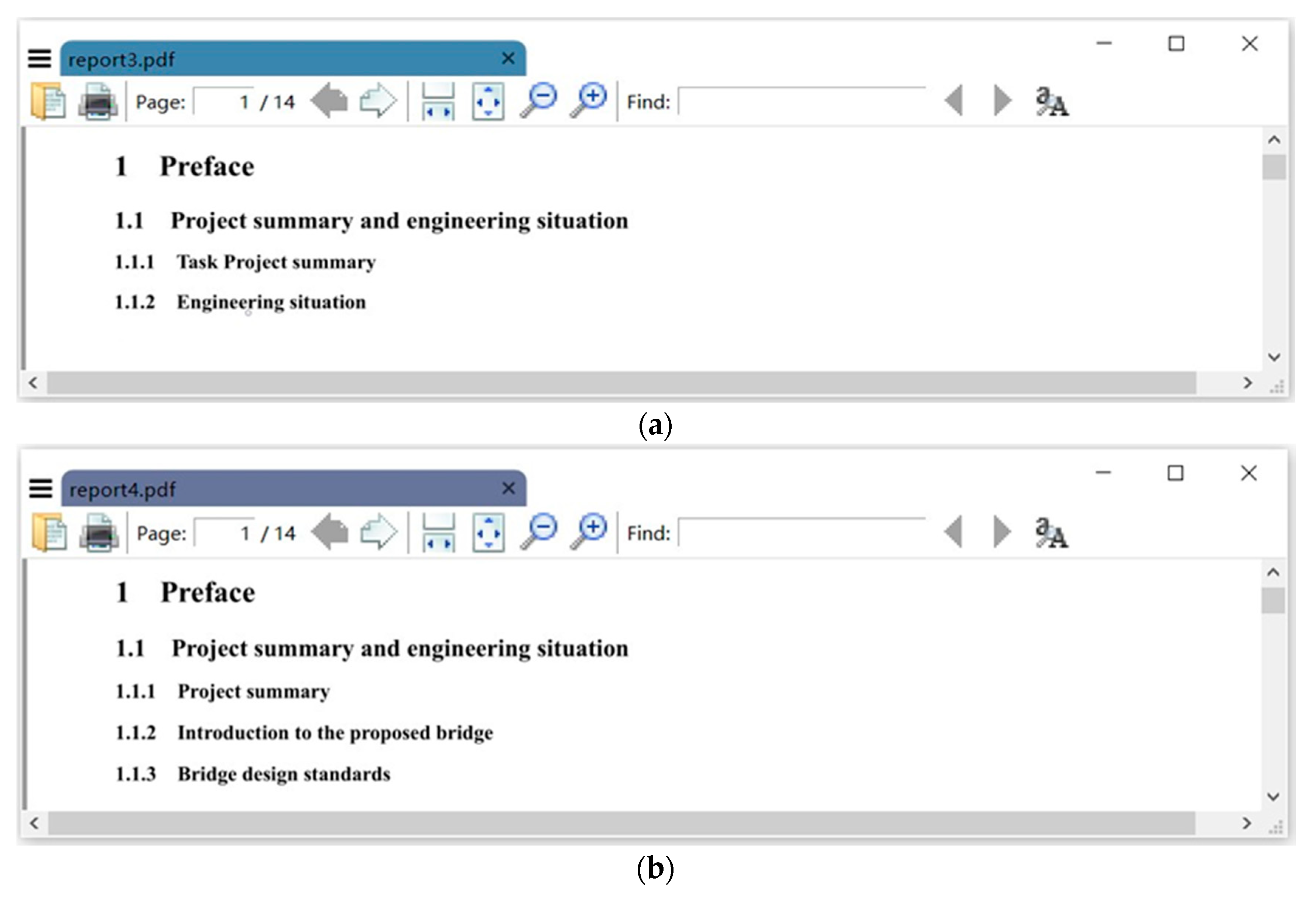
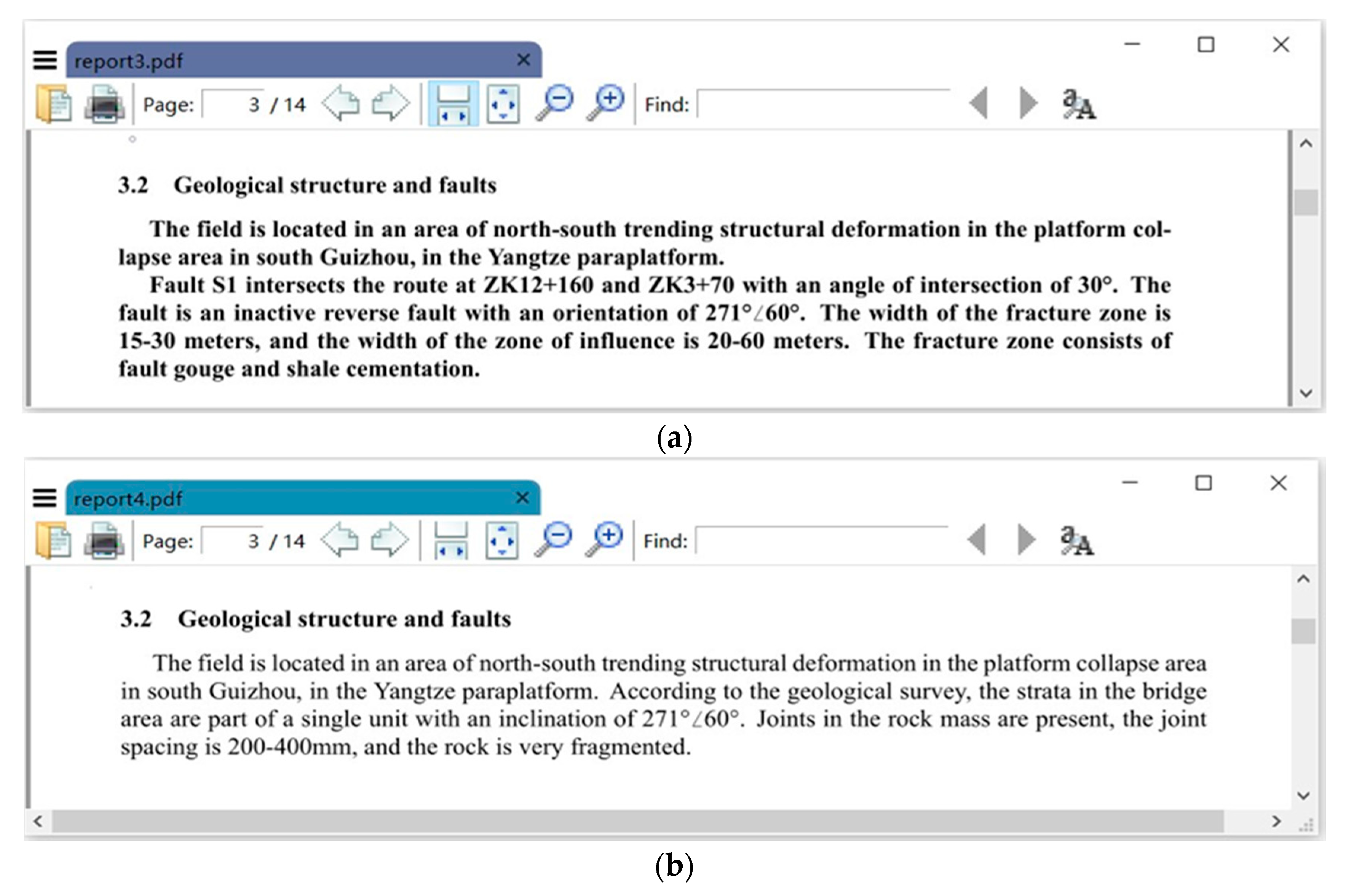

© 2020 by the authors. Licensee MDPI, Basel, Switzerland. This article is an open access article distributed under the terms and conditions of the Creative Commons Attribution (CC BY) license (http://creativecommons.org/licenses/by/4.0/).
Share and Cite
Lei, Y.; Deng, J.; Lin, J.; Dick, J.M.; Lessani, M.N.; Liu, C. Research of Automatic Generation for Engineering Geological Survey Reports Based on a Four-Dimensional Dynamic Template. ISPRS Int. J. Geo-Inf. 2020, 9, 496. https://doi.org/10.3390/ijgi9090496
Lei Y, Deng J, Lin J, Dick JM, Lessani MN, Liu C. Research of Automatic Generation for Engineering Geological Survey Reports Based on a Four-Dimensional Dynamic Template. ISPRS International Journal of Geo-Information. 2020; 9(9):496. https://doi.org/10.3390/ijgi9090496
Chicago/Turabian StyleLei, Yujiao, Jiqiu Deng, Jian Lin, Jeffrey M. Dick, Mohammad Naser Lessani, and Chaoyue Liu. 2020. "Research of Automatic Generation for Engineering Geological Survey Reports Based on a Four-Dimensional Dynamic Template" ISPRS International Journal of Geo-Information 9, no. 9: 496. https://doi.org/10.3390/ijgi9090496
APA StyleLei, Y., Deng, J., Lin, J., Dick, J. M., Lessani, M. N., & Liu, C. (2020). Research of Automatic Generation for Engineering Geological Survey Reports Based on a Four-Dimensional Dynamic Template. ISPRS International Journal of Geo-Information, 9(9), 496. https://doi.org/10.3390/ijgi9090496




